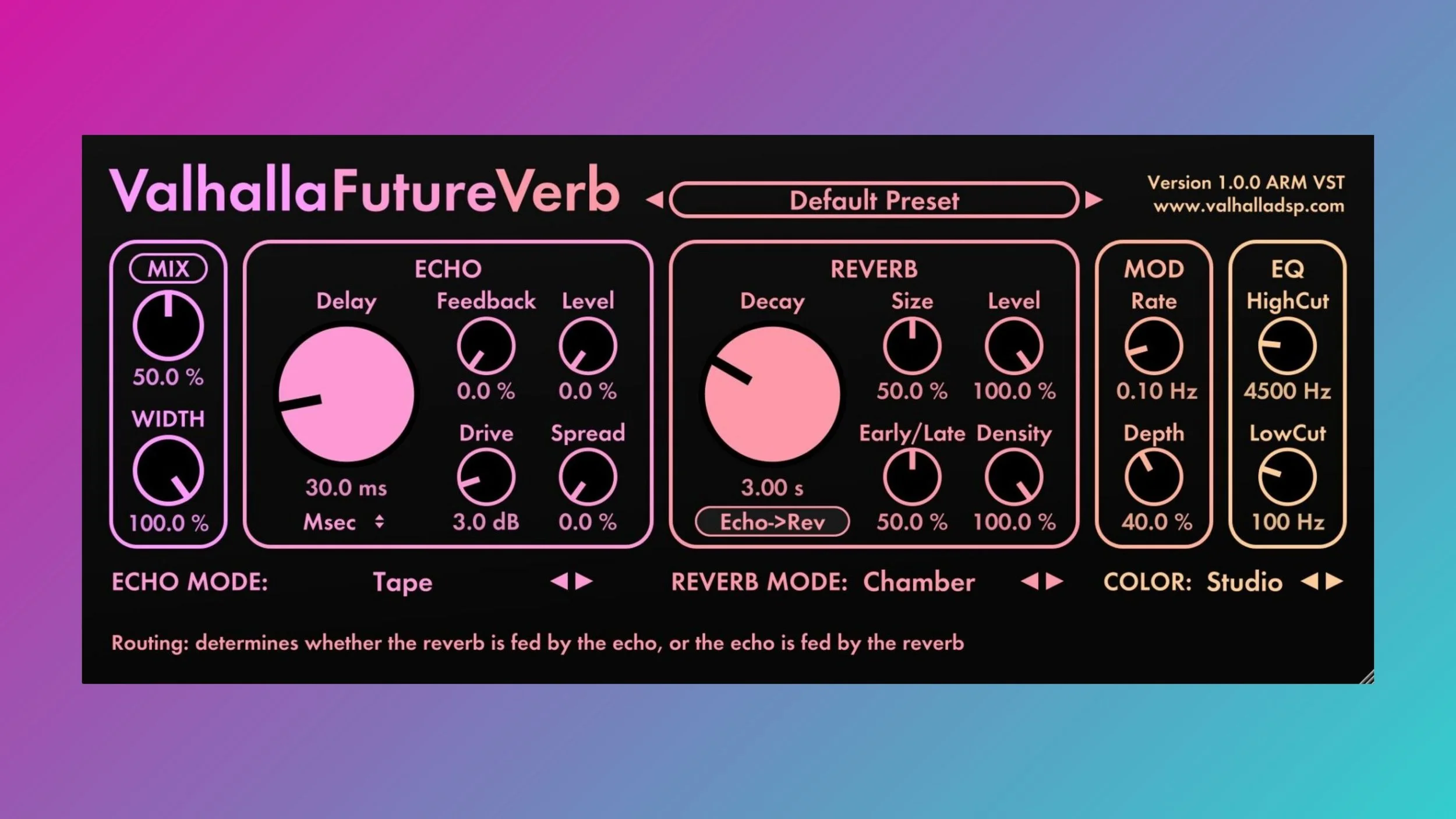Valhalla FutureVerb: Clean Reverb + Wild Echoes in One Plugin

Valhalla DSP has spent the last decade shaping how modern producers think about reverb, and their newest release, Valhalla FutureVerb, feels like a genuine turning point. It arrives after years of quiet development, and you can feel it right away—this isn’t just a new algorithm or a fresh coat of UI paint. It’s a reverb and echo engine merged into one fluid, musical workspace, designed for people who jump between clean mix tasks and experimental sound design without switching plugins. FutureVerb opens up those spaces where ambience and motion blur into each other, giving you subtle rooms, massive halls, evolving textures, and pitch-bent echoes in the same breath. What makes it intriguing is how modern it feels without losing that classic Valhalla ease. It’s still the familiar ethos, but the architecture underneath is ambitious: new color modes, flexible routing, cleaner decays, richer modulation—the kind of update you only get when a developer spends years trying to solve problems instead of recycling ideas. FutureVerb isn’t chasing nostalgia or trying to be a museum piece. It’s a forward-looking spatial tool built for the way people actually produce today: fluid, hybrid, quick to experiment, and always looking for a sound that feels a little unreal in the best way.
What ValhallaFutureVerb Is
Valhalla FutureVerb is the most ambitious effect Valhalla DSP has released since the early VintageVerb days, but it comes from a completely different angle. Instead of leaning on retro coloration or emulating classic hardware, FutureVerb is built around a clean, modern spatial engine that merges reverb and echo into one coherent tool. The idea is simple but powerful: you get a transparent reverb that behaves naturally at any decay length, plus a fully capable echo processor that can shift, smear, or animate the sound before or after it hits the space. It’s the kind of dual-engine design that normally lives in far more expensive flagship plugins, but here it shows up in a streamlined Valhalla format that feels immediately familiar.
The plugin also sits in an interesting spot between utility and inspiration. Used as a straight reverb, it’s clean, controlled, and mix-ready, giving you polished rooms, plates, and halls with none of the metallic edges found in old-school algorithmic designs. But flip the routing, change the echo mode, and suddenly you’re into pitch warping, granular-leaning atmospheres, or rhythmic delays feeding a massive tail. FutureVerb isn’t trying to replace any of Valhalla’s classics—it quietly expands the entire framework. It gives producers a single effect that can handle everyday ambience as easily as those surreal, evolving textures that usually require stacking multiple plugins.
Deep Dive: Algorithms, Controls & Signal Flow
FutureVerb’s power comes from how its pieces fit together: eight new reverb algorithms, twelve echo modes, and a routing system that lets you decide how they interact. The reverb side is built on Valhalla’s newest architecture, designed to stay clean and realistic even when you stretch the decay to absurd lengths. Rooms stay tight, plates stay controlled, and halls open up without washing out the midrange; it’s all intentionally modern, with none of the artificial shimmer or metallic ringing that older digital verbs struggled with. The echo engine is just as flexible, moving from classic tape-style delays to multi-voice pitch tricks, reverse patterns, and more experimental granular-ish modes like Sparkle or Swarm. The big shift is how these two engines feed each other: you can run the echo into the reverb for classic space-building, or flip it and send reverb into the echo, which bends, blurs, or reshapes the tail in ways that feel instantly musical.
What ties everything together is the control layout. FutureVerb keeps Valhalla’s “macro-first” philosophy—big parameters that do something meaningful, fast. You’ve got decay, size, modulation depth, diffusion behavior, and a unified EQ section that shapes both the verb and the echo without forcing you into submenu purgatory. The Color Modes (Bright, Neutral, Dark, Studio) subtly shift the plugin’s entire tonal profile, letting you move from airy and modern to more restrained and mix-focused with a single click. Even small adjustments go a long way: a slightly longer decay combined with a pitch-shifted echo can turn a simple chord into an evolving pad, while a short room paired with a reverse mode can add movement to percussion without sounding like special effects. It’s all expressive, streamlined, and designed for the kind of fast, intuitive sound-sculpting that keeps you in creative mode instead of technical mode.
Workflow, Sound-Design Potential & Real-World Use Cases
Workflow-wise, FutureVerb hits that sweet spot where it feels effortless at first touch but keeps revealing layers the more you push it. You can dial in a basic room or hall in seconds—something Valhalla has always nailed—but the plugin really shines when you start nudging parameters past the ordinary. The modulation behaves in a smooth, cinematic way, adding movement without turning everything into a wobbly wash. The echo engine reacts immediately to creative tweaks, so you can build rhythmic patterns, ghostly reverse hits, or pitched tails without juggling multiple plugins. It feels purpose-built for modern hybrid workflows: one part mixing tool, one part experimental sandbox, always quick to shape and rarely fussy.
Those options translate directly into real-world use cases. For club-focused producers, FutureVerb is great for giving percussion subtle animated tails or stretching synth stabs into atmospheric transitions without muddying the mix. For DJs, it can build breakdown ambience, widen vocals, or create those dreamy pre-drop moments where space becomes part of the rhythm. For more experimental or pop-leaning work, the pitch-shifted echoes and granular-style modes can turn dry pads into evolving textures or add strange, emotional resonances to simple melodies. Even for film/ambient creators, the clean algorithms and long, stable decays make it easy to sculpt vast, floating sound worlds. It’s the rare reverb-delay hybrid that feels truly at home across genres and workflows.
Alternatives & Where FutureVerb Fits in 2025
If you’re choosing your first serious reverb or building a tight, modern toolkit, FutureVerb slots neatly beside the staples you’d normally see in a curated reverb list. FabFilter Pro-R 2 is still the go-to if you want total control, clean tailoring, and a reverb that disappears into the mix without fuss. Baby Audio Crystalline remains the best choice for ultra-polished, forward-facing shine—great for pop vocals and bright electronic productions. Eventide Blackhole is still unbeatable for huge, otherworldly atmospheres. And Denise Perfect Room continues to excel when you want punchy, characterful spaces that respond well to drums and stabs. What makes FutureVerb compelling is that it doesn’t try to replace any of these—it covers a wide middle lane where you get clarity, depth, and creative movement in one place.
FutureVerb is at its best when you want one plugin that can stretch from subtle ambience to experimental texture without stacking effects. If your projects lean heavily toward vintage color, hardware-inspired plates, or ultra-realistic convolution spaces, dedicated tools like UAD’s EMT emulations or Seventh Heaven still make sense. But for most modern producers—especially those working across electronic, pop, ambient, hip-hop, or hybrid genres—FutureVerb fills a gap none of those plugins address alone. It’s clean without being sterile, creative without being niche, and versatile enough to hold its own as your main reverb while also doubling as a sound-design engine. In a crowded market of highly specialized reverbs, FutureVerb stands out because it adapts to whatever you need it to be.
For more info on the best reverb plugins out there, check out our post on the topic.
Verdict
Valhalla FutureVerb feels like the kind of plugin you start using for one tiny task and then quietly realize you’re loading on every project. It’s clean, modern, and intuitive enough to function as an everyday reverb, but the built-in echo engine and flexible routing give it a creative edge that most “normal” reverbs don’t attempt. The algorithms sound polished and natural, the modulation feels tasteful rather than gimmicky, and the whole thing invites experimentation without slowing you down. It’s rare for a spatial plugin to be this streamlined and this deep at the same time.
That said, its strength is also its lane: FutureVerb is for producers who want one tool that can cover a huge range of spatial effects without leaning on heavy vintage character or strict hardware emulation. If you love the color of classic plates, the grain of old digital units, or the realism of convolution reverbs modeled after specific rooms, those remain separate purchases—and they’re still worth having. But if you want a single plugin that can move fluidly between mixing, atmosphere-building, and sound-design weirdness, FutureVerb is one of the most compelling releases of 2025. It’s affordable, it sounds excellent, and it feels built for the way people actually work.
Disclosure: This site contains affiliate links. If you book or purchase through these links, I may earn a commission at no extra cost to you. This helps support the site and keeps my content free. As an Amazon Associate, I earn from qualifying purchases.

